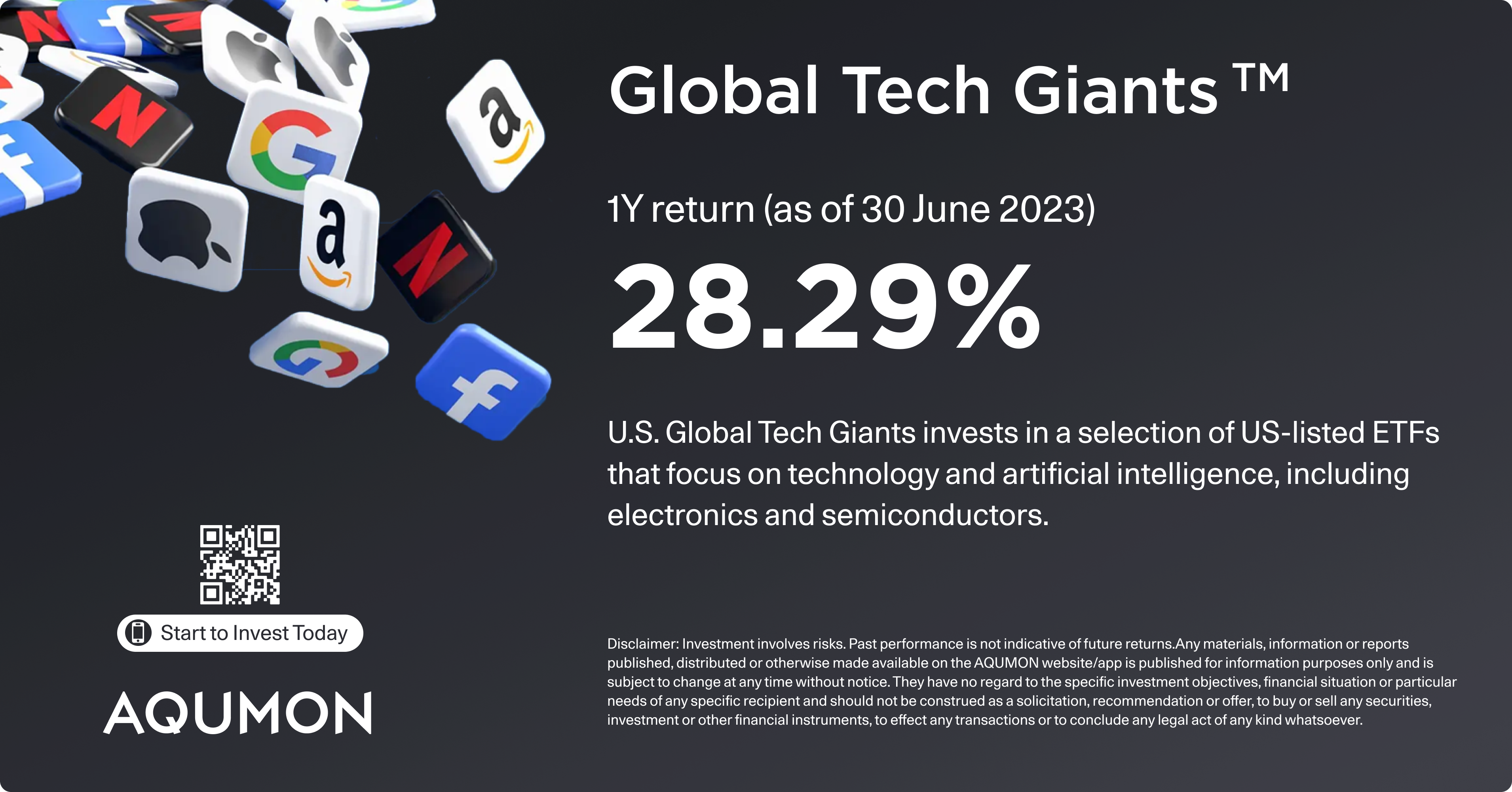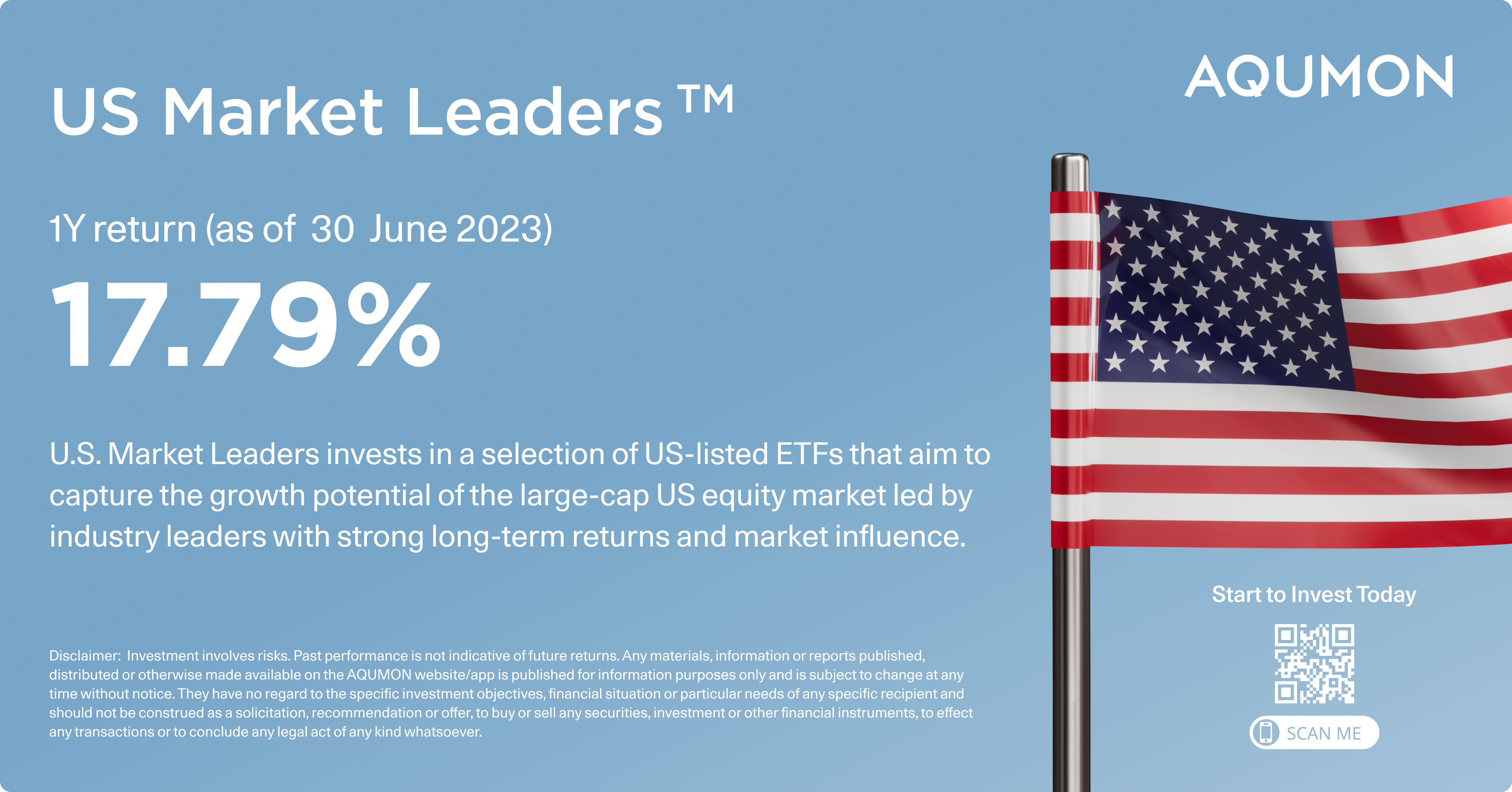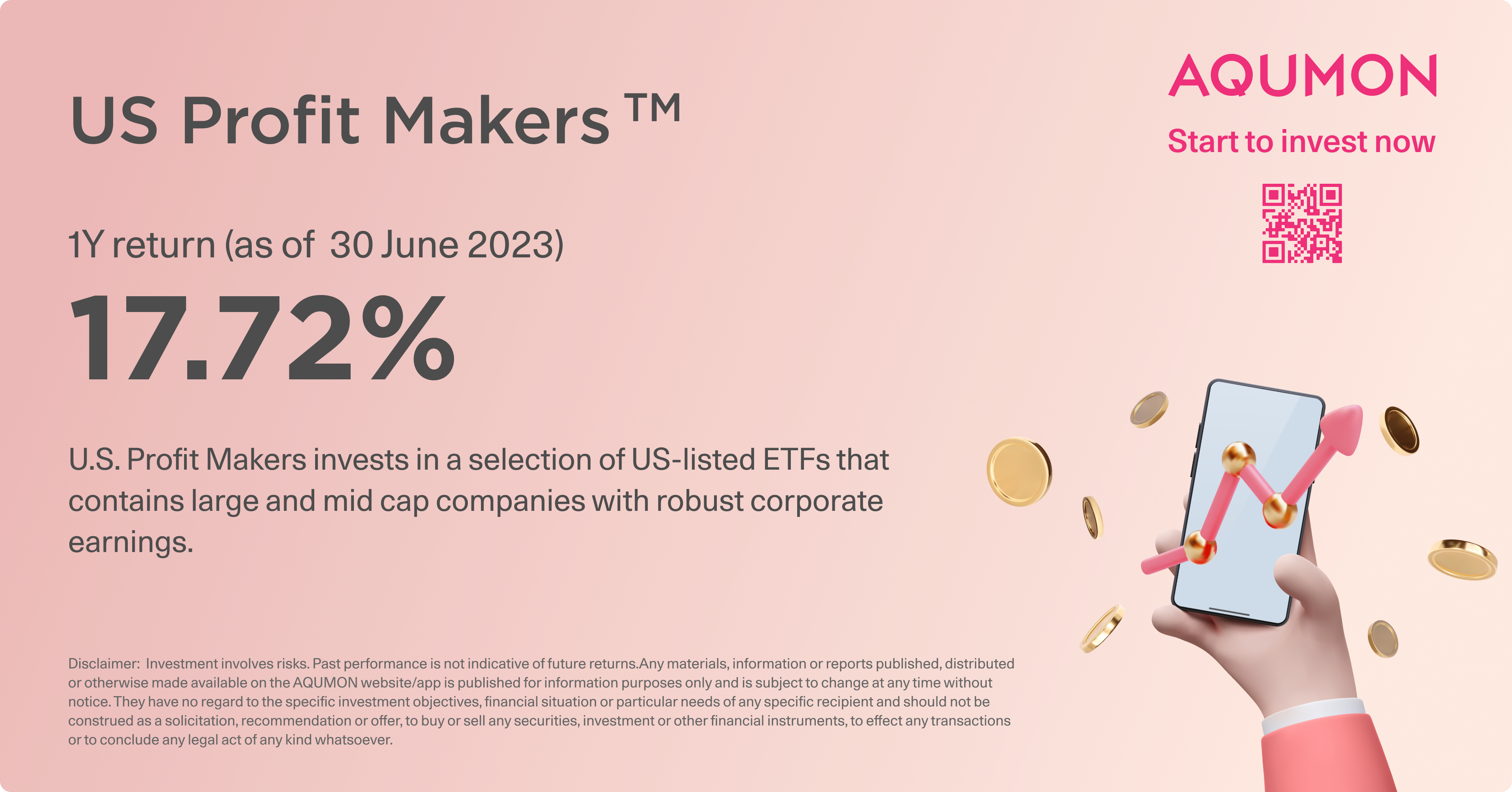
2023 Q2 Market Insights and Portfolio Performance Updates
Written by AQUMON Team on 2023-07-20
2023 Q2 Global Financial Markets Key Highlights
Developed markets, particularly the US, spearheaded the advance in global shares during Q2, while emerging market stocks fell behind.
- US equities ended the quarter higher, driven by gains made in June amid moderating inflation and signs of a resilient US economy despite higher interest rates. Q1 GDP growth was revised upwards to 2%, well above the previous estimate of 1.3% growth. The Federal Reserve raised interest rates by 25 basis points in May but paused in June, with two more rate hikes expected in 2023 according to the "dot plot" of rate predictions. US inflation eased to 0.1% in May, with the economy remaining healthy despite an unexpected increase in the unemployment rate. Congress approved a deal in early June, which resolved investor caution around US debt ceiling concerns. The IT sector led the stock market jump, while energy and utilities underperformed.
- In the second quarter, Chinese stocks experienced a sharp decline as the economic recovery, which followed the reopening of the country after the Covid-19 crisis, began to lose steam. This was triggered by a slowdown in factory output in China, caused by lacklustre consumer spending and weak demand for exports due to interest rate increases in the US and Europe. As a result of the cooling Chinese economy, sentiment towards Hong Kong stocks was also weakened, leading to a decline in their prices during the second quarter.
- The strong momentum in the Japanese stock market picked up pace in June, with the Nikkei 225 rising by 17.74% in the local currency for Q2. Weakness in the Japanese yen also continued, with it hitting levels of 188 yen and 144 yen against the British pound and the US dollar respectively in June, resulting in lower foreign currency denominated returns from Japanese equities. The market hit a 33-year high in June, with the Nikkei 225 reaching 33,700, partly driven by continuous buying in from foreign investors since April. The gains have been supported by ongoing expectations of corporate governance reforms and structural shifts in the Japanese macro economy. Yen weakness and strength in the US market further fuelled a risk-on mode in the Japanese equity market. Despite market valuations, such as the price-to-earnings ratio, reaching a fair level, there seems to be scope for upward earnings revisions in the coming months, supported by yen weakness.
How Did AQUMON’s Portfolios Perform?
AQUMON's global asset allocation strategy is rooted in scientific principles, leveraging big data and algorithms to achieve stable performance for our customers. By employing rigorous risk control and diversification techniques, we help our clients reduce investment risks and achieve a sense of security in their investments.
Recent market indicators suggest a sluggish market, with U.S. retail sales increasing but falling short of expectations and a decline in industrial and manufacturing production last month. However, U.S. banks' higher interest rates have helped to improve profits during the second quarter. Looking ahead, the U.S. Federal Reserve is expected to raise its benchmark overnight interest rate during their upcoming July 26 meeting.
Despite the challenging market conditions, our U.S. portfolios have performed well in the past quarter. Our Global Tech Giants portfolio has increased by 13.01% in Q2, Market Leaders by 6.63% and Profit Makers by 5.27% during same period. Over the past one year, these portfolios have seen impressive growth, with boosts of 28.29%, 17.79%, and 17.72%, respectively.
Will It Be Better in 2023 Q3?
- The tightening of monetary policy and lending standards suggest a recession may be on the horizon in the US, but it's uncertain when it will happen. Signs of labor market slack are emerging, but consumption remains strong, which could prolong the business cycle. However, a tight labor market could lead to persistent strength in wage inflation, adding to inflationary pressures and potentially prompting the Fed to tighten policy further. The Fed's interpretation of inflation components and the direction of future rate decisions will also be important factors. In the fixed income market, shorter-dated securities are expected to be more volatile, while longer-dated securities could remain rangebound at higher levels. Credit is offering attractive yields, but a conservative approach is warranted given the deteriorating macroeconomic backdrop. In the equity market, the S&P 500 Index shows signs of improving dynamics, but a neutral to slightly defensive stance is advisable over a one-year horizon. However, risk-on moves are possible over shorter periods if the threat of a recession diminishes.
- In May and early June, most indicators of cyclical activity revealed an economic slowdown, particularly in credit momentum and property sales, indicating that the reopening rebound is fading. A sustained recovery in household consumption and property sales is required for the cyclical rebound to strengthen beyond the mechanical boost, but there has been limited evidence of either so far. Beijing is expected to lend a helping hand, but there has been limited policy stimulus due to concerns over financial stability and an excessive debt buildup. Highly leveraged property developers and local governments may come under increasing refinancing pressures in a deteriorating credit environment. The financials sector may also face regulatory crackdowns similar to those seen in the technology and education sectors. Chinese equities remain challenged by a stagflationary global economic backdrop and geopolitical risks. However, there are selective strategic opportunities in the renewable energy sector, the digital economy, high-value global manufacturing, advanced technology, and consumption upgrade. Chinese government bond yields are expected to fall further as economic growth continues to trail lofty expectations and the People’s Bank of China refrains from joining the global tightening cycle.
- The Bank of Japan's Governor, Kazuo Ueda, has been cautious about potential tightening and has highlighted that the risk of inflation slowing below the BoJ's target is a greater risk than the risk of it overshooting. The BoJ has stipulated that stronger wage growth is a precondition for policy normalization, but the latest signs of wage growth are not encouraging. The Nikkei 225 has achieved excellent returns year-to-date (29.06%) due to looser monetary and fiscal conditions, but as the macro environment becomes more challenging, there is a preference for stocks with more defensive qualities. While consensus is bearish on USD/JPY, the JPY's volatility adjusted yield is deeply prohibitive to strategic long JPY positions, and Japanese investors are expected to maintain their preference for unhedged foreign bonds.
2023 Half Year Review and Outlook
Although global economic growth accelerated in the first half of the year, reaching 2.8%, the impact of monetary tightening has been compounded by the lingering effects of COVID-19 and Russia's invasion of Ukraine. Consequently, interest-sensitive spending has been affected, and factory output has been hampered. It is unlikely that current momentum will be sufficient to prevent a moderation in growth as the global economy becomes less resilient.
The second half of 2023 will present a more challenging macroeconomic environment for stocks, given the current economic conditions. It appears that global inflation is on a downward trend, although it is expected to remain above desired levels at around 3%. In light of this, it is likely that there will be further tightening measures implemented due to persistently high inflation. However, these measures may lead to a synchronized global recession that could occur before the end of 2024.
China's economy grew by 5.5% in H1 2023, exceeding Beijing's full-year growth target. However, the Q2 results were distorted by pandemic-induced lockdowns last year, and the country is still struggling to gain momentum due to the lingering effects of the pandemic. Rising youth unemployment rates are also a concern, as youth joblessness hit a new high in June. China plans to support its struggling property market and boost business confidence by easing loan terms for property companies and extending certain outstanding loans for a year, including trust loans due by end of 2024.
How Should Investors Adjust Their Asset Allocation?
Given that uncertainty will continue in the third quarter of 2023, investors should keep their defensive positioning by focusing on stable return vehicles. The best way to weather turbulence is through diversification.
-
Drive up diversification on different aspects of the portfolio in the asset class, geographic location & sector.
-
Remain relatively conservative while finding ways to enhance a portfolio's Sharpe ratio*.
-
Place more weighting on Chinese or Chinese-linked assets, which will benefit from low valuations, a recovering economy, and supportive fiscal and monetary policy, while other major global economies continue fiscal and monetary policy tightening.
*One of the widely used methods for calculating risk-adjusted returns. The higher the ratio, the greater the investment return relative to the amount of risk taken, and thus, the better the investment.
Hyper-Personalised Investment Solutions-AQUMON Bespoke
A multi-asset portfolio with global exposure carrying a dynamic allocation pertaining to underlying economic growth could potentially offset current market turmoil if a systematic approach is there to afford the right asset mix plus proper ongoing refinements. Schedule a free consultation with us to learn more about AQUMON's investment products and market-adapting solutions.
You may also contact us via 2155 2816, WhatsApp, or email bespoke@aqumon.com
About us
AQUMON is a Hong Kong based award-winning financial technology company. Our mission is to leverage smart technology to make next-generation investment services affordable, transparent and accessible to both institutional clients and the general public. Through its proprietary algorithms and scalable, technical infrastructure, AQUMON’s automated platform empowers anyone to invest and maximize their returns. AQUMON has partnered with more than 100 financial institutions in Hong Kong and beyond, including AIA, CMB Wing Lung Bank, ChinaAMC, and Guangzhou Rural Commercial Bank. Hong Kong University of Science and Technology, the Alibaba Entrepreneurs Fund, affiliate of BOC International Holdings Limited, Zheng He Capital Management and Cyberport are among AQUMON's investors.
The brand is held under Magnum Research Limited and is licensed with Type 1, 4 and 9 under the Securities and Futures Commission (SFC) of Hong Kong. AQUMON is also licensed by the U.S. Securities and Exchange Commission (SEC) and the Asset Management Association of China (AMAC).
Disclaimer
Viewers should note that the views and opinions expressed in this material do not necessarily represent those of Magnum Research Group and its founders and employees. Magnum Research Group does not provide any representation or warranty, whether express or implied in the material, in relation to the accuracy, completeness or reliability of the information contained herein nor is it intended to be a complete statement or summary of the financial markets or developments referred to in this material. This material is presented solely for informational and educational purposes and has not been prepared with regard to the specific investment objectives, financial situation or particular needs of any specific recipient. Viewers should not construe the contents of this material as legal, tax, accounting, regulatory or other specialist of technical advice or services or investment advice or a personal recommendation. It should not be regarded by viewers as a substitute for the exercise of their own judgement. Viewers should always seek expert advice to aid decision on whether or not to use the product presented in the marketing material. This material does not constitute a solicitation, offer, or invitation to any person to invest in the intellectual property products of Magnum Research Group, nor does it constitute a solicitation, offer, or invitation to any person who resides in the jurisdiction where the local securities law prohibits such offer. Investment involves risk. The value of investments and its returns may go up and down and cannot be guaranteed. Investors may not be able to recover the original investment amount. Changes in exchange rates may also result in an increase or decrease in the value of investments. Any investment performance information presented is for demonstration purposes only and is no indication of future returns. Any opinions expressed in this material may differ or be contrary to opinions expressed by other business areas or groups of Magnum Research Limited and has not been updated. Neither Magnum Research Limited nor any of its founders, directors, officers, employees or agents accepts any liability for any loss or damage arising out of the use of all or any part of this material or reliance upon any information contained herein.



